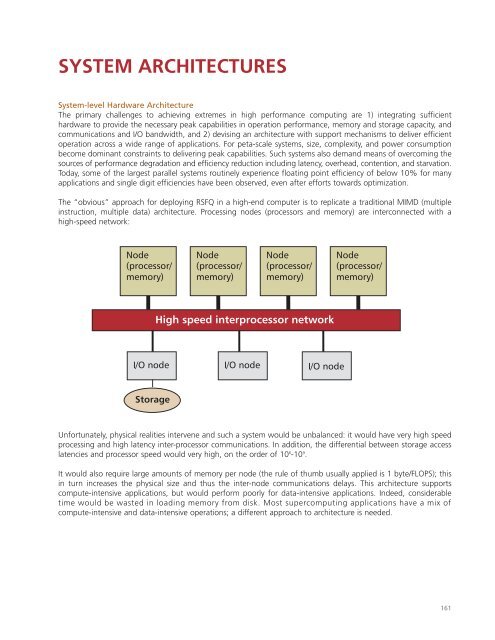Superconducting Technology Assessment - nitrd
Superconducting Technology Assessment - nitrd
Superconducting Technology Assessment - nitrd
You also want an ePaper? Increase the reach of your titles
YUMPU automatically turns print PDFs into web optimized ePapers that Google loves.
SYSTEM ARCHITECTURES<br />
System-level Hardware Architecture<br />
The primary challenges to achieving extremes in high performance computing are 1) integrating sufficient<br />
hardware to provide the necessary peak capabilities in operation performance, memory and storage capacity, and<br />
communications and I/O bandwidth, and 2) devising an architecture with support mechanisms to deliver efficient<br />
operation across a wide range of applications. For peta-scale systems, size, complexity, and power consumption<br />
become dominant constraints to delivering peak capabilities. Such systems also demand means of overcoming the<br />
sources of performance degradation and efficiency reduction including latency, overhead, contention, and starvation.<br />
Today, some of the largest parallel systems routinely experience floating point efficiency of below 10% for many<br />
applications and single digit efficiencies have been observed, even after efforts towards optimization.<br />
The “obvious” approach for deploying RSFQ in a high-end computer is to replicate a traditional MIMD (multiple<br />
instruction, multiple data) architecture. Processing nodes (processors and memory) are interconnected with a<br />
high-speed network:<br />
Node<br />
(processor/<br />
memory)<br />
Node<br />
(processor/<br />
memory)<br />
Node<br />
(processor/<br />
memory)<br />
I/O node I/O node I/O node<br />
Storage<br />
High speed interprocessor network<br />
Node<br />
(processor/<br />
memory)<br />
Unfortunately, physical realities intervene and such a system would be unbalanced: it would have very high speed<br />
processing and high latency inter-processor communications. In addition, the differential between storage access<br />
latencies and processor speed would very high, on the order of 10 6 -10 9 .<br />
It would also require large amounts of memory per node (the rule of thumb usually applied is 1 byte/FLOPS); this<br />
in turn increases the physical size and thus the inter-node communications delays. This architecture supports<br />
compute-intensive applications, but would perform poorly for data-intensive applications. Indeed, considerable<br />
time would be wasted in loading memory from disk. Most supercomputing applications have a mix of<br />
compute-intensive and data-intensive operations; a different approach to architecture is needed.<br />
161










